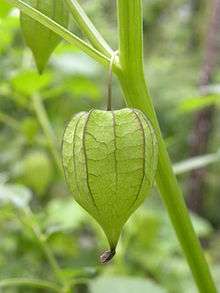Physalis minima
Physalis minima is a species of perennial herbs elonging to the family Solanaceae. Native gooseberry, wild cape gooseberry and pygmy groundcherry are some of the popular common names in English. It is a pantropical annual herb 20–50 cm high at its maturity. It can be found near the marshes of Java.
| Physalis minima | |
|---|---|
 | |
| Scientific classification | |
| Kingdom: | Plantae |
| Clade: | Tracheophytes |
| Clade: | Angiosperms |
| Clade: | Eudicots |
| Clade: | Asterids |
| Order: | Solanales |
| Family: | Solanaceae |
| Genus: | Physalis |
| Species: | P. minima |
| Binomial name | |
| Physalis minima | |
Leaves are soft and smooth (not furry), with entire or jagged margins, 2.5–12 cm long. Cream to yellowish flowers are followed by edible yellowish fruit encapsulated in papery cover which turns straw brown and drops to the ground when the fruit is fully ripe.[1]

The plant tends to have a weedy character, often found growing in disturbed sites.
Uses
The fruit has a pleasant cherry-tomato like flavor when fully ripe.
Often used to relieve pain (analgesic action). In a study the whole plant extract has shown anti-inflammatory and analgesic action in rats.[2]
The fruit can be dispersed by wind. The dispersal mechanism is called balloon mechanism. The space between the fruit and the covering calyx works as air bladder at early stages. The fruit is called 'bon-tepari' or simply 'tepari' in Bengali.
References
- Low, T. (1991). Wild Food Plants of Australia. Australia: HarperCollins. ISBN 9780207169304.
- Khan, M. A.; Khan, H.; Khan, S.; Mahmood, T.; Khan, P. M.; Jabar, A. (2009). "Anti-inflammatory, analgesic and antipyretic activities of Physalis minima Linn". Journal of Enzyme Inhibition and Medicinal Chemistry. 24 (3): 632–637. doi:10.1080/14756360802321120. PMID 18825533.